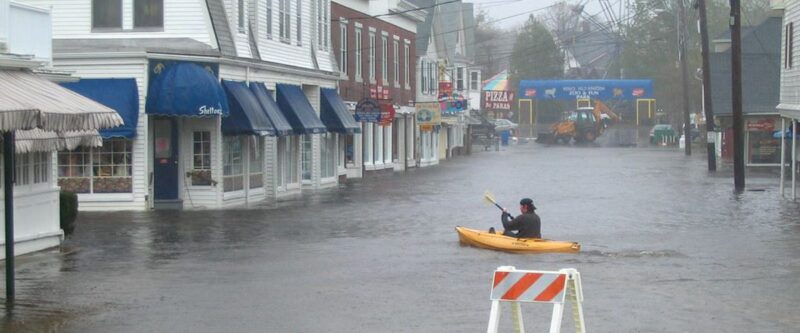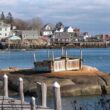Instead of relying solely on models and charts, what if we tried to visualize just how different our lives might be in a climate-altered Maine two decades hence? What follows is an imaginative portrait grounded in what science is forecasting. This snapshot assumes that the world makes progress in cutting greenhouse gas emissions, moderating but not eliminating the dystopian changes in store. (The picture could grow far darker given the current regulatory rollbacks and burning of the Amazon.)
The wind shifted northwest overnight, bringing in high pressure. Traditionally, that meant crisp Canadian air, but today the breeze carries soot from wildfires in Quebec, where drought and pest damage have made for a bad fire season.
It’s expected to top 90 degrees again today. I still recall in the late teens when temperatures in the low 90s began breaking records. Not any more.
Thank goodness for the ductless heat pump. We depend on that almost more for cooling than for heating, especially on days when high ozone and particulates leave lungs feeling sun-burned.
I’d like to beat the heat by swimming, but I don’t dare. The lake already had one toxic algal bloom this season, following a 5-inch deluge.
The bay’s warm enough to swim in, but there are rumors of Vibrio. Those bacteria were just a concern for shellfish harvesters at first, but lately, the flesh-eating strains are surfacing farther north.
I can’t help but wonder, too, what toxic chemicals are in those waters as several abandoned buildings are partly submerged. There must be asbestos, lead paint and other hazards washed off with every high tide.
The plan had been for voluntary buybacks at market value so those structures could be razed. But federal flood programs ran dry, and the state budget can barely keep roadways open.
The town can’t carry that burden on its own. Its budget has fallen with the loss in tax revenues as people walked away from shorefront properties. And municipal costs are rising – given more storm damage and road washouts.
Before the day heats up too much, I’ll bike to the supermarket to see if more has come in. Supplies have been sparse, and what does get delivered goes out the door quickly.
I recall years in which I began the day with Central American coffee and a banana or kiwi flown in from some tropical place. Now it’s oats from the County, local blueberries and chamomile tea.
Back then, there was a “slow food” movement, reacting to all the processed, packaged food. It’s all pretty slow and simple these days, with coffee and chocolate a distant (and bittersweet!) memory.
Like the World War II victory gardens, nearly everyone has converted useless lawn into some edible crop, and canning is back in fashion. Maine has been lucky most years to have adequate water, but the summer dry spells can be hard.
And the weather is so erratic. Every year now, we lose a few crops to weird temperature fluctuations.
At least when the storms hit, which they do with greater frequency and ferocity, most people have some local power source to fall back on: solar, wind or – for farmers – methane from manure. Maine showed some foresight in the 2020s by moving to locally generated power so far fewer people now are vulnerable in the ice storms and heatwaves.
Maine today seems almost more like it was in the 19th century than the 20th century. That stretch in between was an anomalous time of living big, wasting freely and driving and flying everywhere. Then the climate tab came due.
Even the landscape is more reminiscent of the 19th century, with less forest and more farmland. Now it’s not just due to agricultural clearing, though, but to a glut of insects and diseases.
Emerald ash borer started killing off those venerable trees around 2020. Then several different needle diseases attacked the white pines. A plague of moths – gypsy, browntail, winter – kept after the oaks for so many seasons that many of them died.
Despite the altered landscape, visitors still see us as Vacationland, coming here for some relief from the heat farther south. And for a growing number of people, we’re Destinationland – with refugees from around the country and abroad coming here to start afresh after floods, fires or civil unrest.
There was once hand-wringing about Maine’s population loss and how to sustain the workforce needed to keep our economy going. We needn’t have worried.
The state deserves some credit for the work it did in the ’20s to weatherize and renovate old manufacturing buildings and outsized residences – creating smaller, energy-efficient residential units. That drew newcomers and helped revitalize downtowns. And it has largely kept sprawl from overtaking the lands we now need for farming.
People are less drawn to rural settings anyway, given the tick situation. It was bad enough when Lyme disease started spreading, but then came babesiosis, anaplasmosis and powassan virus. Within a decade, we were finding lone star ticks and the dreaded Asian longhorn tick.
Now ticks are an omnipresent worry. Never having known anything else, the kids today are pretty stoical about all the challenges– the bugs, heat, ozone pollution, runoff soup and subsistence cuisine.
But for those of us who remember a more vibrant place, and a time when different choices could have been made, this diminishment is an abiding heartache.




